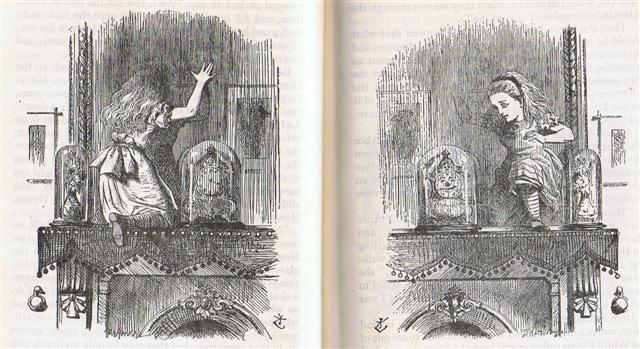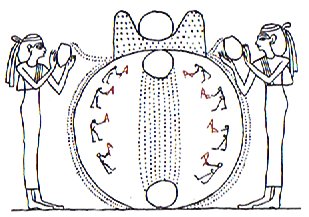3-5. A quick answer to my question could be to say that whereas the
Battleaze refers to the place of the Girl (the dorsal side)
the Adze refers to the place of the facial side (the Rat):
325 - 314 = 11 (→ 366 - 12 * 29½).
To. 1. Particle
sometimes used with the article in ancient legends; i uto to
te hau, the ribbon was in the float. 2. To rise (of the sun)
during the morning hours up to the zenith: he-to te raá.
Vanaga. 1. Of. T Pau., Ta.: to, of. Mgv.: to,
genitive sign. Mq.: to, of, for. 2. This, which.
Churchill. Mgv.: To, to make a canoe of planks. Mq.:
to, to build a canoe. Sa.: to, to build. Churchill.
Ki. To, towards (a place, a person); after (time); for,
in order to ... Vanaga. Kî. To say, to speak; word,
language; will, wish (verbally expressed): e-hakarogo koe ki
te kî o toou matu'a, obey you father's will. Vanaga. 1. In,
toward, to, for, at; ki ra, there; ki ra hoki,
exactly there; ki aho, outside; ki roto, within,
into, inside, among. 2. In order that. 3. To say, to speak, to
chat, to pronounce, to respond; argument, conversation,
description, doctrine, expression, word, relation; ki
veveveve, voluble; ki vaiapuga, nonsense, to speak
much and say nothing; ki ihoiho, to speak forcefully.
Churchill.
|
Al Sa’d al Bula'-21 (Good Fortune of the
Swallower)
/
Dhanishta-24 (Most Famous)
/
Girl-10 (Bat)
YUE
(Battle-Axe) = ψ
Capricorni
(314.3),
GIENAH CYGNI =
ε
Cygni,
η
Cephei (314.5),
γ
Delphini (314.6),
σ
Pavonis (314.7),
ALBALI =
ε
Aquarii
(314.8)
BETELGEUZE (α
Orionis) |
BATEN ALGIEDI (Belly of the Goat) =
ω
Capricorni
(315.8) |
μ
Aquarii (316.0) |
ε
Equulei (317.8) |
No
star listed (318) |
21h (319.6)
ARMUS =
η
Capricorni
(319.0),
DORSUM =
θ
Capricorni
(319.3),
TSOO = 24 Capricorni
(319.7) |
DRAMASA =
σ
Oct.,
χ
Capricorni (320.0),
ν
Aquarii (320.3),
γ
Equulei (320.6),
ο
Pavonis (320.8) |
 |
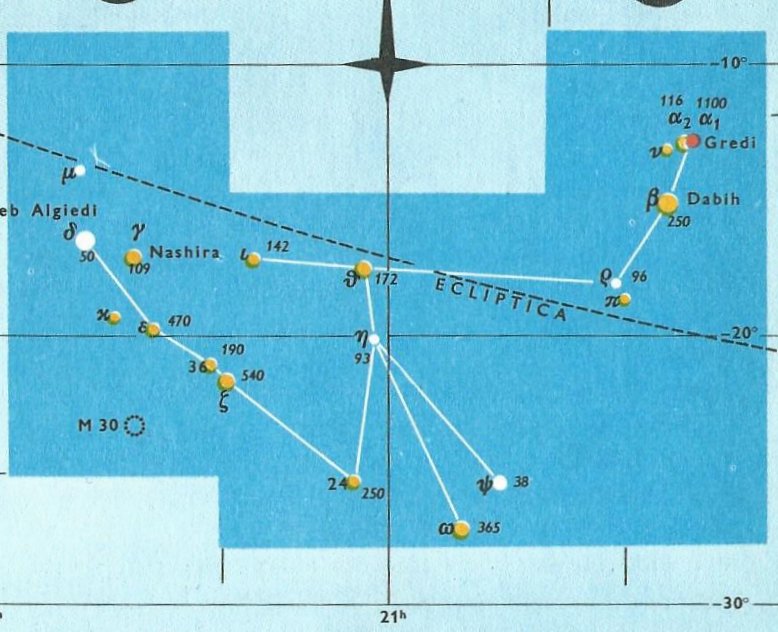 |
| Jan
29 |
30 |
31
(396) |
Febr 1 (32) |
2 |
3 |
4 (400) |
|
... The Sacred Book of the ancient
Maya Quiche, the famous Popol Vuh (the Book of Counsel) tells of
Zipacna, son of Vucub-Caquix (= Seven Arata). He sees 400 youths
dragging a huge log that they want as a ridgepole for their house.
Zipacna alone carries the tree without effort to the spot where a hole
has been dug for the post to support the ridgepole. The youths, jealous
and afraid, try to kill Zipacna by crushing him in the hole, but he
escapes and brings down the house on their heads. They are removed to
the sky, in a 'group', and the Pleiades are called after them ... |
 |
 |
 |
 |
 |
 |
 |
|
Ea3-12
(77) |
Ea3-13 |
Ea3-14 →
π |
Ea3-15
(80) |
Ea3-16 |
Ea3-17 |
Ea3-18 |
| tagata mau toki |
ko te vae |
toki |
henua |
toki |
kiore - hokohuki |
kiore tupu |
|
... In China, with Capricornus,
Pisces, and a part of Sagittarius, it [Aquarius] constituted the early
Serpent, or Turtle, Tien Yuen; and later was known as Hiuen
Ying, the Dark Warrior and Hero, or Darkly Flourishing One, the
Hiuen Wu, or Hiuen Heaou, of the Han dynasty,
which Dupuis gave as Hiven Mao. It was a symbol of the emperor
Tchoun Hin, in whose reign was a great deluge; but after the Jesuits
came in it became Paou Ping, the Precious Vase. It contained
three of the sieu, and headed the list of zodiac signs as the Rat,
which in the far East was the ideograph for 'water', and still so
remains in the almanacs of Central Asia, Cochin China, and Japan
...

Tupu. 1.
Shoot, sprout, bud; to sprout, to bud. 2. Pregnant: vî'e tupu (o te
poki); to be conceived (of fetus in its mother's womb): he-tupu
te poki i roto i te kopú o toona matu'a. Vanaga. To grow, to sprout,
to germinate, to come forth, to conceive, pregnant, germ; mea tupu,
plant; tupu ke avai, of rapid growth; tupu horahorau,
precocious; hakatupu, to produce, to stimulate growth, to excite.
P Pau.: fakatupu, to raise up, to create. Mgv.: tupu, to
grow, to conceive, to be pregnant. Mq.: tupu, to grow, to sprout,
to conceive. Ta.: tupu, to grow, to sprout. Churchill. Mgv.:
Tupu, the best or worst, used of men or of bad qualities. Sa.:
tupu, king. Ma.: tupu, social position, dignity. Churchill.
... Another year passed, and a man by the name of
Ure Honu went to work in his banana plantation. He went and came to
the last part, to the 'head' (i.e., the upper part of the banana
plantation), to the end of the banana plantation. The sun was standing
just right for Ure Honu to clean out the weeds from the banana
plantation. On the first day he hoed the weeds. That went on all day,
and then evening came. Suddenly a rat came from the middle of the banana
plantation. Ure Honu saw it and ran after it. But it disappeared
and he could not catch it. On the second day
of hoeing, the same thing happened with the rat. It ran away, and he
could not catch it. On the third day, he reached the 'head' of the
bananas and finished the work in the plantation. Again the rat ran away,
and Ure Honu followed it. It ran and slipped into the hole of a
stone. He poked after it, lifted up the stone, and saw that the skull
was (in the hole) of the stone. (The rat was) a spirit of the skull (he
kuhane o te puoko). Ure Honu was amazed and said, 'How
beautiful you are! In the head of the new bananas is a skull, painted
with yellow root and with a strip of barkcloth around it.' Ure Honu
stayed for a while, (then) he went away and covered the roof of his
house in Vai Matā. It was a new house. He took the very large
skull, which he had found at the head of the banana plantation, and hung
it up in the new house. He tied it up in the framework of the roof (hahanga)
and left it hanging there ... |
|
γ
Pyxidis (133.6) |
ζ
Hydrae (134.1),
ρ
Cancri (134.2),
ζ
Oct.
(134.3), ο Cancri (134.6), δ Pyxidis (134.9) |
ACUBENS
= α Cancri,
TALITHA BOREALIS = ι Ursae Majoris
(135.0),
σ Cancri (135.2), ρ Ursa Majoris (135.6) |
ν Cancri
(136.0),
TALITHA
AUSTRALIS = κ Ursae Majoris
(136.1),
ω Hydrae (136.8) |
9h (137.0)
σ¹ Ursa Majoris (137.0), κ Cancri (137.3),
τ Cancri (137.4),
ALSUHAIL (al Wazn, of the
Weight) = λ Velorum
(137.5), σ² Ursa Majoris (137.6), τ Ursa Majoris (137.7), ξ Cancri
(137.8)
*96.0 = *137.4 - *41.4 |
κ
Pyxidis (138.0), ε Pyxidis (138.5) |
π
Cancri (139.2),
MIAPLACIDUS =
β
Carinae
(139.3),
TUREIS (Little Shield) =
ι
Carinae
(139.8) |
 |
|
July 31 (212) |
Aug
1 |
2
(314 - 100) |
3
(580 = 397 + 183) |
4 (2 * 108) |
5 |
6
(139 + 79) |
|
... It was 4 August 1968, and it was
the feast day of Saint Dominic, patron of Santo Domingo Pueblo,
southwest of Santa Fe. At one end of the hot, dusty plaza, a Dominican
priest watched nervously as several hundred dancers arranged in two long
rows pounded the earth with their moccasined feet as a mighty,
collective prayer [ui] for rain, accompanied by the powerful
baritone singing of a chorus and the beat of drums. As my family and I
viewed this, the largest and in some ways the most impressive Native
American public ceremony, a tiny cloud over the Jémez Mountains to the
northwest got larger and larger, eventually filling up the sky; at last
the storm broke, and the sky was crisscrossed by lightning and the
pueblo resounded with peals of rolling thunder ... |
Betelgeuze (*88) culminated at 21h in January 29 and
January 29 (*314) + *11 = *325 (February 9). This was the
11th Chinese station at
Sadalsud. 77 (Ea3-12 →
360) + 11 =
88 (Ea3-23).
... Sadalsuud - not Sund nor
Saud, as frequently written - is from Al Sa'd al Su'ud, liberally
translated the Luckiest of the Lucky, from its rising with the sun when the
winter had passed and the season of gentle, continuous rain had begun.
In my astronomy book Sadalsud is translated as
'the Lucky Star of the Whole World', which makes more sense - the earth as a
whole is lucky to receive the gentle rain which will revive her.
This title also belongs to the 22nd manzil,
which included the star with ξ of Aquarius and c [also referred to as 46] of
Capricornus ...
... In 1922,
Henry Norris Russell aided the IAU (International Astronomical Union) in
dividing the celestial sphere into 88 official constellations. Where possible,
these modern constellations usually share the names of their Graeco-Roman
predecessors, such as Orion, Leo or Scorpius. The aim of this system is
area-mapping, i.e. the division of the celestial sphere into contiguous fields.
Out of the 88 modern constellations, 36 lie predominantly in the northern sky,
and the other 52 predominantly in the southern ...

|
α Oct. (321.5), δ
Equulei (321.7),
φ
Capricorni (321.8) |
KITALPHA (Part of a Horse) =
α
Equulei
(322.0),
ALDERAMIN (The Right Arm) =
α
Cephei
(322.9) |
DAI =
ι
Capricorni
(323.5),
β
Equulei (323.8) |
γ
Pavonis (324.1),
YAN =
ζ
Capricorni
(324.6) |
Al Sa'd al Su'ud-22
(Luckiest of the Lucky)
/
Emptiness-11 (Rat)
TSIN = 36 Capricorni
(325.2),
ALPHIRK (The Flock) =
β
Cephei
(325.7),
SADALSUD =
β
Aquarii,
ξ
Gruis (325.9) |
No star listed (326) |
CASTRA =
ε
Capricorni
(327.2),
BUNDA (Foundation) =
ξ
Aquarii
(327.5)
SIRIUS (α Canis Majoris) |
Mahar sha hi-na Shahū-26
(Western One in the Tail of the Goat)
NASHIRA (Fortunate One) =
γ
Capricorni
(328.0),
ν
Oct. (328.3),
AZELFAFAGE (Horse's Foot Track) =
π¹
Cygni,
κ
Capricorni (328.7) |
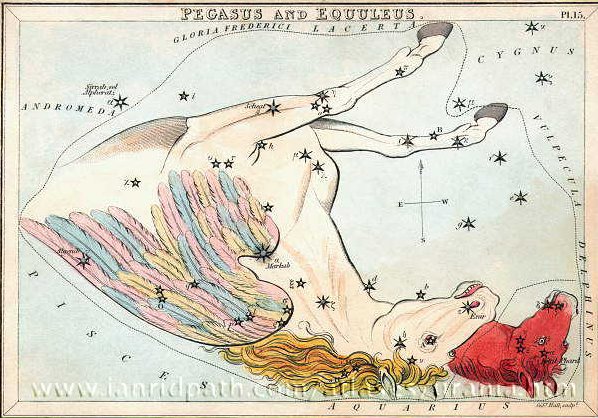 |
|
Febr 5 (36) |
6 |
7 |
8 (404) |
9 (40) |
10 |
11 |
12 (408) |
|
... On February 9 the Chorti Ah K'in,
'diviners', begin the agricultural year. Both the
260-day cycle and the solar year are used in setting
dates for religious and agricultural ceremonies,
especially when those rituals fall at the same time
in both calendars. The ceremony begins when the
diviners go to a sacred spring where they choose
five stones with the proper shape and color. These
stones will mark the five positions of the sacred
cosmogram created by the ritual. When the stones are
brought back to the ceremonial house, two diviners
start the ritual by placing the stones on a table in
a careful pattern that reproduces the schematic of
the universe. At the same time, helpers under the
table replace last year's diagram with the new one.
They believe that by placing the cosmic diagram
under the base of God at the center of the world
they demonstrate that God dominates the universe.
The priests place the stones in a very particular
order. First the stone that corresponds to the sun
in the eastern, sunrise position of summer solstice
is set down; then the stone corresponding to the
western, sunset position of the same solstice. This
is followed by stones representing the western,
sunset position of the winter solstice, then its
eastern, sunrise position. Together these four
stones form a square. They sit at the four corners
of the square just as we saw in the Creation story
from the Classic period and in the Popol Vuh.
Finally, the center stone is placed to form the
ancient five-point sign
modern researchers called the quincunx ...
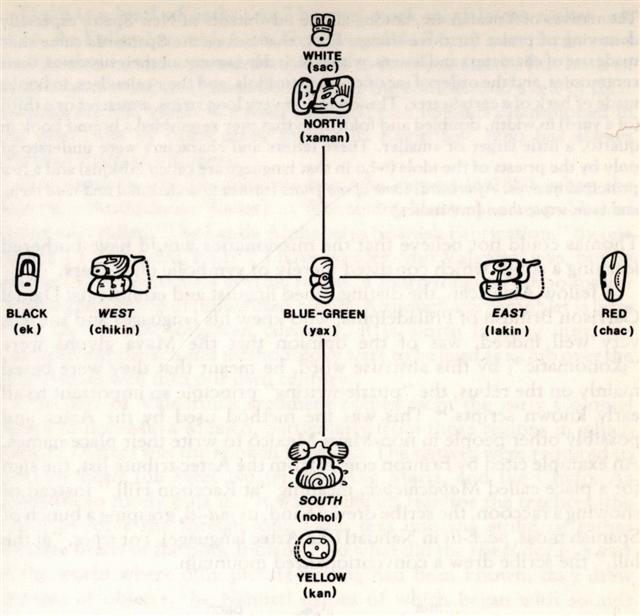
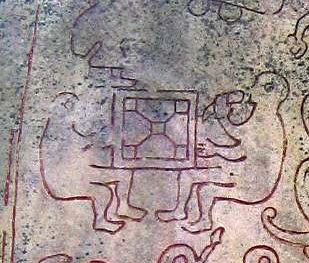 |
 |
 |
 |
 |
 |
 |
 |
 |
|
Ea3-19
(84) |
Ea3-20 |
Ea3-21 |
Ea3-22 |
Ea3-23
(88) |
Ea3-24 |
Ea3-25 |
Ea3-26 |
| tagata
rere toki |
manu puo
pouo |
toki |
mauga |
toki i te henua ku tutu
raua |
marama |
marama |
|
Tutu, 1. Circle of fishing nets arranged
in the shape of a funnels or baskets. 2. To light a
fire; he-tutu i te ahi: to burn something. 3.
To hit, to strike, to beat. Tûtú, to shake
(something) clean of dust or dirt; he-tûtú te
oone o te nua, to shake the dirt off a nua
cape. Tutuhi, to reject the responsibility
for a mistake onto one another, to blame one another
for a mistake (see tuhi). Tutuki, to
stumble, to trip. O tutuki te va'e, in order
not to trip. Tutuma, firebrand, partly burnt
stick. Tuturi, to kneel. Vanaga. 1. To beat
bark for cloth. PS Pau., Mgv., Mq., Ta.: tutu,
id. Sa., To., Fu.: tutu, id. 2. A broom, to
sweep, to clean. Mq.: tutu, to beat out the
dust. 3. To shake, to winnow. Mgv.: tutu, to
tremble, to leap. Mq.: tutu, to shake. 4. To
kindle, to light, to ignite, to set fire, to burn.
Mq.: tutu, to burn, to set fire. 5. To stand;
hakatutu, to set joists. P Mgv., Mq.: tutu,
to stand upright. Ta.: tu, id. Tutua (tutu
1): board on which bark is beaten into cloth. PS
Mgv.: tutua, a cloth beater. Mq., Ta.:
tutua, wood on which cloth is beaten. Sa., Fu.:
tutua, id. Tutui: tutui ohio,
chain, tutui kura, shawl. Mq.: tuitui kioé,
chain. Tutuki: shock, contusion, to run
against, to collide; tukukia, to run foul of.
P Pau.: tukituki, to strike, to pound, to
grind. Mgv.: tukia, to strike against, shock,
concussion. Mq.: tutuki, id. Ta.: tui,
id. Tutuma: 1. (tutu - ma) a
live coal. 2. Tree trunk T (? tumu).
Tutumata, ligament of the eye, orbit, eyelid. T
(tutumate, eyelid G). Tutuu,
bristling. Churchill. |
3 days later, in February 12 (365 + 43 = 408) the Sun would be at
Nashira (γ Capricorni, the
Fortunate One, *328.0), i.e. 8 days after the right
ascension line connecting to Dramasa
(*320.0).
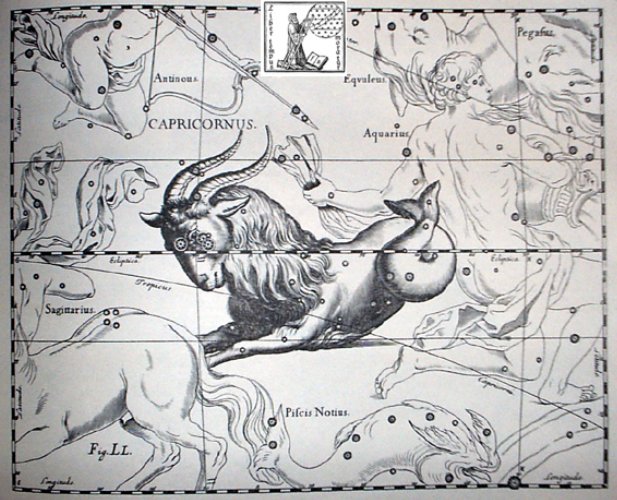
Then, in February 14 came All Hearts' Day:
|
Arkat sha hi-na Shahū-27
(Eastern One in the Tail of the Goat)
ENIF (The Nose) =
ε
Pegasi, ERAKIS (the Dancer) =
μ
Cephei
(329.2),
46 CAPRICORNI,
JIH (the Sun) =
κ
Pegasi
(329.3),
ι
Piscis Austrini (329.4),
λ
Capricorni (329.6),
ν
Cephei (329.7),
DENEB ALGIEDI =
δ
Capricorni
(329.8)
*288.0 = *329.4 - *41.4 |
θ
Piscis Austrini (330.1),
λ
Oct.
(330.7) |
KUH (Weeping)
=
μ
Capricorni (331.4),
γ
Gruis (331.5)
*290.0 = *331.4 - *41.4 |
|
Febr 13 |
All Hearts' Day |
15 (46) |
 |
 |
 |
|
Ea3-27
(84 + 8) |
Ea3-28 |
Ea3-29
(46 + 48) |
|
tagata - te vai |
hokohuki - kiore - hokohuki -
kiore |
kiore kikiu |
|
... In the
inscriptions of Dendera, published by Dümichen, the
goddess Hathor is called 'lady of every joy'.
For once, Dümichen adds: Literally ... 'the lady of
every heart circuit'. This is not to say that the
Egyptians had discovered the circulation of the
blood. But the determinative sign for 'heart' often
figures as the plumb bob at
the end of a plumb line coming
from a well-known astronomical or surveying device,
the merkhet. Evidently, 'heart' is something
very specific, as it were the 'center of gravity'
... See Aeg.Wb. 2, pp. 55f. for sign of the heart (ib)
as expressing generally 'the middle, the center'.
And this may lead in quite another direction. The
Arabs preserved a name for
Canopus - besides calling the star Kalb
at-tai-man ('heart of the south') ... Suhail
el-wezn, 'Canopus Ponderosus', the
heavy-weighing Canopus, a name promptly declared
meaningless by the experts, but which could well
have belonged to an archaic system in which Canopus
was the weight at the end of the plumb line, as
befitted its important position as a heavy star at
the South Pole of the 'waters below'. Here is a
chain of inferences which might or might not be
valid, but it is allowable to test it, and no
inference at all would come from the 'lady of every
joy'. The line seems to state that Hathor (=
Hat Hor, 'House of Horus') 'rules' the
revolution of a specific celestial body - whether or
not Canopus is alluded to - or, if we can trust the
translation 'every', the revolution of all celestial
bodies. As concerns the identity of the ruling lady,
the greater possibility speaks for Sirius, but Venus
cannot be excluded; in Mexico, too, Venus is called
'heart of the earth'. The reader is invited to
imagine for himself what many thousands of such
pseudo-primitive or poetic interpretations must lead
to: a disfigured interpretation of Egyptian
intellectual life ...

... The
Pythagoreans make Phaeton fall into Eridanus,
burning part of its water, and glowing still at the
time when the Argonauts passed by. Ovid stated that
since the fall the Nile hides its sources. Rigveda
9.73.3 says that the Great Varuna has hidden the
ocean. The Mahabharata tells in its own style why
the 'heavenly Ganga' had to be brought down. At the
end of the Golden Age (Krita Yuga) a class of
Asura who had fought against the 'gods' hid
themselves in the ocean where the gods could not
reach them, and planned to overthrow the government.
So the gods implored Agastya (Canopus, alpha
Carinae = Eridu) for help. The great Rishi did as he
was bidden, drank up the water of the ocean, and
thus laid bare the enemies, who were then slain by
the gods. But now, there was no ocean anymore!
Implored by the gods to fill the sea again, the Holy
One replied: 'That water in sooth hath been digested
by me. Some other expedient, therefore, must be
thought of by you, if ye desire to make endeavour to
fill the ocean ... |
... Early on Sunday morning, 14 February
1779, Captain Cook went ashore with a party of marines to
take the Hawaiian king, Kalaniopu'u, hostage against the
return of the Discovery's cutter, stolen the night before in
a bold maneuver - of which, however, the amiable old ruler
was innocent. At the decisive moment, Cook and Kalaniopu'u,
the God and the King, will confront each other as cosmic
adversaries. Permit me thus an anthropological reading of
the historical texts. For in all the confused Tolstoian
narratives of the affray - among which the judicious
Beaglehole refuses to choose - the one recurrent certainty
is a dramatic structure with the properties of a ritual
transformation. During the passage inland to find the king,
thence seaward with his royal hostage, Cook is metamorphosed
from a being of veneration to an object of hostility. When
he came ashore, the common people as usual dispersed before
him and prostrated face to earth; but in the end he was
himself precipitated face down in the water by a chief's
weapon, an iron trade dagger, to be rushed upon by a mob
exulting over him, and seeming to add to their own honors by
the part they could claim in his death: 'snatching the
daggers from each other', reads Mr. Burney's account, 'out
of eagerness to have their share in killing him'. In the
final ritual inversion, Cook's body would be offered in
sacrifice by the Hawaiian King
...
... At the beginning of 44 B.C. - when Ceasar was still alive
- the Senate decided to raise statues of him in all the temples and to sacrifice
to him on his birthday in the month Quintilis, which in honour of him was
renamed July. He was raised to the status of a god (among the other gods of the
state) under the name Jupiter Julius. Marcus Antonius, who this year was consul
together with Caesar, became high priest and responsible for the ceremonies. In
the middle of February, at the time of the old feast of Lupercalia [Lupus
= Wolf], he ran around naked and whipped the Roman ladies with thongs made from
goat-skin [februa], in order to promote their fertility
...
... I
became interested in what really happened at March 15 and reopened Henrikson to
find out: Caesar was forewarned of the threat by the prophet Spurinna, who told
him that a great threat was coming at Idus Martiae or just before.
The day arrived and Caesar was still living. He was walking to his meeting with
the Senate when he happened to encounter Spurinna and told him jokingly that he
was still alive. Spurinna calmely answered that the day had yet not ended. The
Romans divided their months in two parts and the dividing point was Idus,
which in some way was connected with full moon. March 15 was the midpoint of
March, which is close to spring equinox. The old agricultural year defined the
beginning of the year to the time when sun returned, and it was connected with
Mars ...
... The chaotic tumult in the Curia (where the Senate
had their meeting and where they killed Caesar) resulted in his dead body left
lying on the floor, while all the Senators panicked and ran out through the
doors in different directions. They had planned to throw his body into the
river, but the time of plans and order was in the past. Instead, in the
afternoon, three of the slaves of Caesar came and fetched his body, and carried
him on a stretcher to his home south of Forum - and one arm was hanging down in
the corner where the 4th slave should have been
...
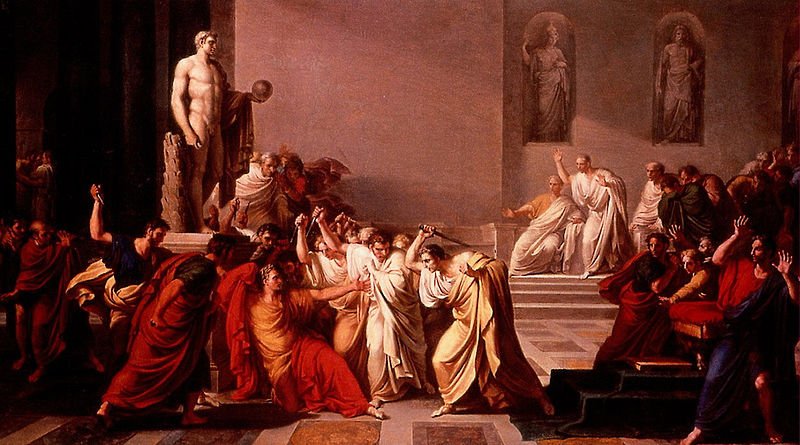
Cook → to cook.
... The Hawaiian woman who was interviewed chuckled because
the assassination of Captain Cook coincided with the day we have named All
Hearts' Day - when in February 14 (2-14) the war-god Kuu returned to
power ...

|
